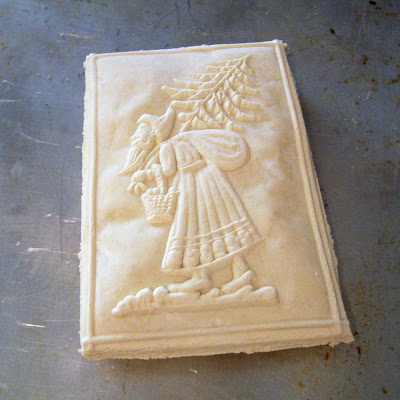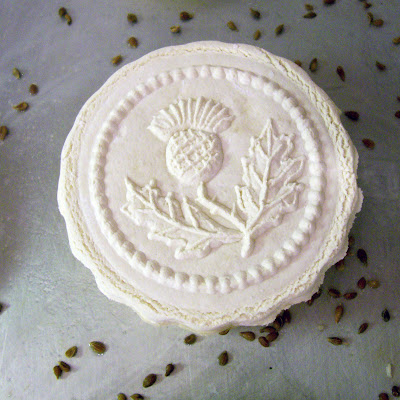The Sun rises from over the Wasatch Mountains. A lone baker stands in his kitchen, sipping a cup of assam tea. A low heat emanates from the oven behind him. Pacing back and forth, like a general about to lead his Six Hundred into the Valley of Death, he gives a final inspection to the 21 raw springerle cookies that are lined up like soldiers on two steel sheet pans. The Baker turns on his heel, opens the oven door, and places the first of the two pans into the oven. The Third Battle of the Springerle has begun.
The Baker, having closed the oven door, thinks back on his previous engagements with The Springerle. A veteran of two previous battles, he is tired of being beaten, and feels that victory is in reach. He remembers the First Battle. Though the cookies tasted good, the detail of the image pressed into the dough was poor, and all the cookies ended up having large voids or pockets just beneath the surface, and the springerle failed to grow their traditional "feet." The Second Battle ended again with the Baker in retreat. He had decided to reduce the amount of baking powder from one teaspoon, to 3/4 teaspoon. Still, despite this adjustment, the void persisted, though the "feet" almost grew; he could see that the bottoms of the cookies had risen, but not enough to be "feet." So the Baker, defeated a second time, went to consult with his advisers.
First, he went to the creator of the molds he had used to press the springerle, Mr. Gene Wilson. Mr. Wilson advised reducing the temperature of the oven a bit. He also mentioned the effects of humidity and altitude while baking springerle. The Baker agreed, having dealt with the challenge of high-altitude baking many times before. The Baker then consulted his baking allies at The Springerle House. They too agreed that he should reduce the temperature of his oven from 300º F to 250º or 275º F. They also advised that he extend the baking time from 15 minutes to 20 or even 25 minutes.
As for the lack of detail, the Baker decided to allow the rolled dough to first warm up a bit, then having placed the mold, he jumped up on the table and knelled on the mold. (Understand, the Baker is not a big guy, so it takes do effort to press the cookie.)
The Baker applied these insights and techniques on this morning, as he waited for the first tray to finish baking.
Five minutes passed...then ten minutes...then fifteen. He peeked in the oven to see what had become of his springerle. What he saw astounded him, the springerle were floating. He closed the door, while joy and anticipation welled within him. Finally, twenty minutes had passed. He once again open the oven door and pulled out the sheet pan. Here is what awaited his gaze...
good, sharp detail, and...
the Weinachtsmann, standing up on his foot. Yes! The springerle had doubled in thickness, not by puffing up, but by growing a foot.
Encouraged by this new success, he placed the second sheet pan, this one holding cookies made with his new thistle mold, into the oven. Twenty minutes at 275º F later, again, success!
Sharp detail and a fluted edge (thanks to a linzer cookie cutter he didn't even know he had), and...
Monday, October 22, 2007
Subscribe to:
Post Comments (Atom)








4 comments:
Tom,
I have collected springerle molds for a few years now. Your cookies turned out really good. What recipe did you use? Have you tried any of the recipes with butter?
JP
I used the recipe that came with the springerle. Here it is.
My changes were to reduce the baking powder to 3/4 tsp, reduce the oven temp to 275ºF, and to bake them for 20 minutes.
Thanks. I've been making them for a few years now, but still always seem to be experimenting with the dough or looking for a better recipe. Your pics were great. I saw your post on bakespace and tried to repond there, but I'm still waiting for account activation. Your post has me looking at new molds and getting in gear for this springerle season :o)
Send me a PM when you get onto the forums. I'd love to talk springerle with another enthusiast!
Post a Comment